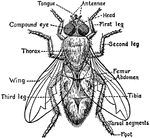How Many Legs Does a Fly Have?

Have you ever wondered, "How many legs does a fly have?" This seemingly simple question often sparks curiosity, especially among children and those interested in entomology. Flies, being one of the most common insects, play a significant role in ecosystems and human environments. Understanding their anatomy, particularly their legs, can provide insights into their behavior and survival mechanisms. In this post, we’ll explore the fascinating world of flies, focusing on their leg structure, functions, and more. (fly anatomy, insect legs, entomology basics)
The Basic Anatomy of a Fly

Flies belong to the order Diptera, which means “two wings.” However, their legs are equally intriguing. A fly has six legs, a common trait among insects. These legs are segmented and adapted for various functions, such as walking, jumping, and even tasting. Each leg consists of five main parts: the coxa, trochanter, femur, tibia, and tarsus. The tarsus, or the “foot,” often has claws and adhesive pads, allowing flies to land on surfaces with ease. (fly legs, insect anatomy, Diptera order)
Why Do Flies Have Six Legs?

The six-legged structure is a hallmark of insects, including flies. This design provides stability and agility, essential for their survival. Flies use their legs not only for movement but also for:
- Grooming: Cleaning their wings and bodies.
- Tasting: Flies taste food with their legs before eating.
- Climbing: Navigating vertical surfaces like walls and windows.
This adaptability makes flies highly successful in diverse environments. (insect survival, fly behavior, leg functions)
Comparing Fly Legs to Other Insects

While flies have six legs, it’s interesting to compare them with other insects. For instance, spiders have eight legs, and centipedes have numerous legs. The table below highlights these differences:
| Insect | Number of Legs |
|---|---|
| Fly | 6 |
| Spider | 8 |
| Centipede | Varies (typically 15-30 pairs) |

Understanding these differences helps in identifying and studying various insects. (insect comparison, spider legs, centipede anatomy)
💡 Note: Flies’ legs are covered in tiny hairs and sensors, which help them detect chemicals and navigate their surroundings.
How to Observe Fly Legs

If you’re curious to see a fly’s legs up close, here’s a simple checklist:
- Use a magnifying glass to observe the segments and tiny structures.
- Watch a fly land on a surface to see its legs in action.
- Compare with other insects to notice the differences.
Observing flies can be both educational and fascinating. (fly observation, magnifying glass, insect study)
Looking for Fly Control Solutions?

While understanding fly anatomy is intriguing, dealing with fly infestations can be challenging. If you’re looking for effective fly control products, consider:
- Fly traps: Ideal for indoor use.
- Insecticides: For outdoor fly management.
- Natural repellents: Eco-friendly options for homes.
Explore our range of fly control solutions to keep your space fly-free. (fly traps, insecticides, natural repellents)
How many legs does a fly have?
+A fly has six legs, a common trait among insects.
What are fly legs used for?
+Fly legs are used for walking, grooming, tasting, and climbing.
How do fly legs differ from spider legs?
+Flies have six legs, while spiders have eight legs.
Flies, with their six legs, are remarkable creatures adapted for survival. From their segmented legs to their unique functions, understanding their anatomy sheds light on their behavior and importance in ecosystems. Whether you’re an enthusiast or dealing with fly-related issues, this knowledge can be both enlightening and practical. Remember, observing nature’s smallest details often reveals its greatest wonders. (fly survival, ecosystem role, nature observation)



